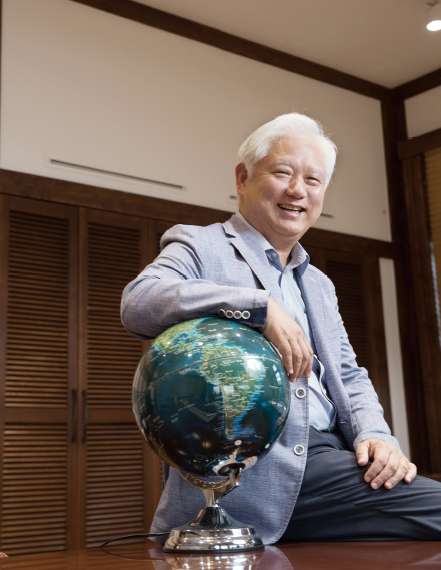New Business Model of R&DB Based on Meticulous Preparation and Strategies
The era when the possession of natural resources determines the destiny of a country has come to an end. The resource that will be leading the era of the 4th Industrial Revolution is the human brain, the power of thinking.
Due to not being complacent about its reputation, Korea University has been at the forefront of innovation by placing research at the center of the changes and challenges it has been pursuing.
Recently, the university has won several, large-scale research projects, overcoming the limitations a private university, which is not sponsored by the Korean government, faces.
It is also noteworthy that it has secured the University Startup Funds and has been selected as one of the partners in the state-funded LINC+ Project. These achievements are the fruits of KU's efforts to strengthen its research capabilities begun two years ago.

Kwan Young Lee, KU Executive Vice President for Research, provided details about the achievements: “As of 2016, research funds earned from commissioned projects reached 291 billion won.
Our goal for this year is to increase that amount to 300 billion. While the rate of increase in the government budget allocations for R&D was 1.1% in 2016, that of the university was 3.9%, which was a continuation of a higher level of budget increases over the past three years.
In particular, the amount of funds earned from large-scale research projects commissioned by organizations such as the National Research Foundation of Korea, the Ministry of Science and ICT, and the Ministry of Trade, Industry and Energy has increased continuously, reaching 44.7 billion won last year.
We put significance on the diversification of organizations which awarded the university research projects, not merely on our financial gain from those projects.”
Winning those large-scale, research projects made up a large proportion of the increases in the research funds of the university; the year-on-year increase rate of big research projects was 140% for 2016.
Lee continued: “We did some research on the major authorities related to R&D projects. We discovered which businesses and projects the government has been supporting and could also forecast which field or industry the government would invest in and direct our research efforts accordingly.
These state-funded projects, which are usually large in scale, necessitate an interdisciplinary convergence and the forming of groups of research teams rather than individual study. Despite such a necessity, however, it is rare to see researchers collaborate on a given project.
Imagine a large number of researchers from different areas working together on a huge project. No doubt there will be difficulties and challenges facing them.
However, if we look at the big picture – for our society and country – rather than working individually, we need to cooperate with each other and upgrade our capabilities to challenge and address issues on a bigger scale.”
Since his inauguration, KU President Jaeho Yeom has reshuffled the university's administration from the previous system having a Provost and Executive Vice President and Executive Vice President for Administration and External Affairs to a new system having an Executive Vice President for Academic Affairs and Executive Vice President for Research.
His reorganization plan is focused on dividing the university system into education and research areas and having two different leaders for each. Under the new system, the Office of Research Planning was established and managed along with the existing Office of Research Management, KU Research and Business Foundation, Technology Holdings, and Crimson Business Innovation Center.
By doing so, the university is now able to provide a customized research plan and support for each researcher and to encourage individual researchers to form larger groups. All of these have helped the university to take a strategic approach to national research projects.
Lee elaborated on the university reorganization: “The establishment of the Office of Research Planning has led to quantitative increases in research funds as well as qualitative growth in research by proactively analyzing the research investments made by the government and finding out the core businesses that the government is concentrating on.
From now on, the competitiveness of a university will be evaluated based on the quantity of high quality, intellectual properties that the university produces.
The Office of Research Planning has created profiles of researchers and made them public so that anyone interested – whether on- or off-campus – can access the information and investigate the possibilities of joint research.”
As part of its efforts to pioneer future research, Korea University began its KU-Future Research Grant (KU-FRG) project in August 2016. Five billion won was allocated for the fund to support future-oriented research projects regardless of their research outcomes.
All of these efforts added up to solidifying the foundation for trans-disciplinary studies and group research efforts, including international cooperation and public-private partnerships.

Universities in the Future Should Stand on Their Feet
In the era of the 4th Industrial Revolution, universities will not only become the epicenter of new knowledge creation, but will also work as hubs for creating added value.
Research outcomes will not only be published or linked to getting patents, but will be commercially viable through technology transfers or startup companies.
This will be a virtuous cycle of research.
Korea University has an annual budget of more than 1 trillion won. Tuition fees received, however, total less than 300 billion won, demonstrating the gap between revenue and expenditures the university must fill.
Lee emphasized university financial independence by saying that, “Universities in the future should stand on their own feet without relying on tuition.”
According to Lee, universities now relying on donations and tuition as their major sources of revenue must in the future generate revenue based on research. Stanford University in the United States is an example of such a university.
Approximately 30 to 40 percent of its budget comes from revenues earned from patents, technology transfer and research outcomes produced by its faculty. In 2016, it earned more than 100 billion won from technology transfer.
Every year, companies owned by its alumni earn a combined 2.7 trillion dollars, almost twice as much as the GDP of South Korea. It surely is involved in the creation of enormous economic values.
Revenues earned from technology transfer by Korean universities is only 3 percent of those of American universities. Of course, it is not necessary for Korean universities to take Stanford University as their role model.
However, Executive Vice President Lee put it this way.
“We have a different investment climate from the States. Approaches and mindsets that investors have are also quite different from those of American investors.
However, there is no doubt that technology commercialization by universities is essential for expanding university budgets and improving national competitiveness.
At a time when more than half of all PhDs are working or studying at universities, it is inevitable for us, universities, to do something to create new values. Otherwise, neither our nation nor university can promise a bright future,” said Lee.
Lee said that the Korea University Medical Applied Research and Development Global Initiative Center (KU-MAGIC) was founded in order to commercialize research achievements made in the bio-medical field.
He added that he expected to see excellent research achievements made at the convergence research center established recently.
According to him, all of these were closely linked to a scheme wherein the university takes full responsibility from the beginning of research to its end in order to reap any resulting profits.
Every human being has a moment when he stands on his own feet without anyone helping him.
To a child who just learned how to stand alone, the world is full of joy and excitement.
Just like a toddler, Korea University is about to take a new leap forward to becoming a self-supporting university through technology commercialization.



